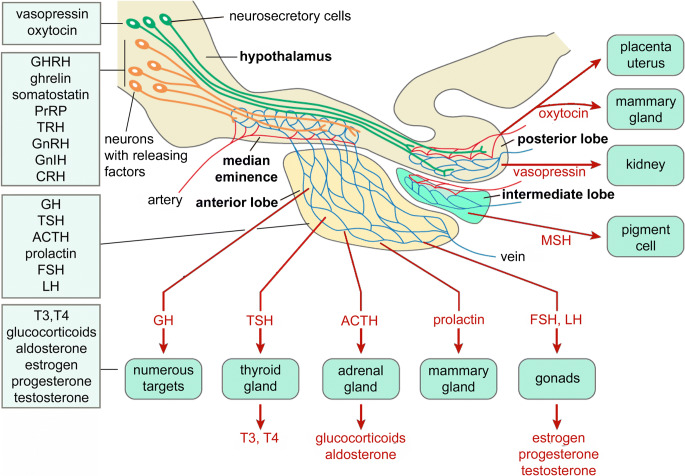Fig. 12.
Signaling in hypothalamus and pituitary in mammals. This scheme presents the most common factors seen in the hypothalamus-pituitary axes of mammals. The intermediate pituitary lobe (with its separate capillary network) and MSH signaling are not found in humans and many other mammals. Peptides are released from hypothalamic neuroendocrine cells into separate capillary networks. Sets of neuroendocrine cells release neuropeptides to the anterior lobe of the pituitary via capillaries in the median eminence. These peptides regulate the release of pituitary peptide hormones produced by endocrine cells of the anterior lobe (these cells are not shown). Additionally, dopamine and GABA exert influence on the endocrine cells (not shown). The posterior capillary network receives peptide hormones (oxytocin and vasopressin) from large hypothalamic neurons whose axons project to the posterior lobe of the pituitary. These peptides are released into the general circulation that transports them to distant target organs. The different hormones produced in the anterior lobe are also released into circulation and act on multiple targets. Some target organs (thyroid, adrenal and gonads) in turn produce “secondary” hormones of different kinds. Some of these hormones provide feedback to the hypothalamus. Abbreviations: GHRH, growth hormone–releasing hormone; PrRP, prolactin-releasing peptide; TRH, thyrotropin-releasing hormone; GnRH, gonadotropin-releasing hormone; GnIH, gonadotropin-inhibiting hormone, CRH, corticotropin-releasing hormone; GH, growth hormone; TSH, thyroid-stimulating hormone; ACTH, adrenocorticotropic hormone; FSH, follicle-stimulating hormone; LH, luteinizing hormone; T3, triiodothyronine; T4, thyroxine; MSH, melanocyte-stimulating hormone. This figure is updated from Nässel and Larhammar (2013), with permission

